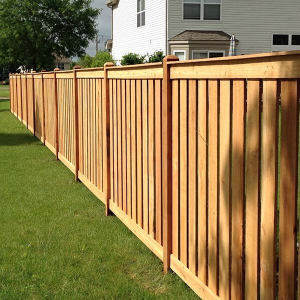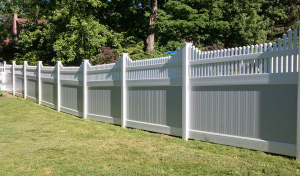Fence is a solid barrier that defines a property line or keeps something from entering a property. Homeowners can pick from a variety of materials and designs to fit their needs. Contact Fence Company Summerville SC now!
Fences may be made of living plants such as hedges in Britain and continental Europe or of cactus in Mexico, of timber such as palisade walls and post-and-rail fences, or of wire. Often they are topped by gates.

A fence is a barrier to prevent people from entering a specific area, typically in the case of homes or businesses. There are many types of fencing, but the main purpose of each one is to protect a particular space from unauthorised entry. Fences are used around buildings, houses, farms, lakes, rivers and even on the edge of cliffs to stop people falling from high places. A fence can also be made of wires or cables to stop animals from getting too close. There are different types of fencing, including the gallows (a structure for hanging criminals).
In addition to traditional fencing, there is an emerging practice known as e-fencing, which describes transactions that involve fraudulently obtained goods or services that are sold through online marketplaces. These transactions may take place entirely on the darknet, or they may include a mix of e-fencing and more traditional forms of fencing. E-fencing can involve physical goods that have been shoplifted or otherwise stolen, as well as virtual items such as digital currency and banking information.
The responsibilities of fences were largely defined by the law and social custom of their times. The occupation was typically taken on by people who had been convicted of other crimes, such as petty thieves or even professional gangsters who needed to sell their stolen merchandise quickly and discreetly. A fence could act as a go-between to sell stolen goods, or he might buy stolen items directly from a thief or other criminal source. In the latter case, he might falsely tell the seller that the market for his type of product was flooded and that he would have to pay a lower price.
Fences often disguised the stolen nature of their goods by removing, defacing or replacing serial numbers. They might also transport the goods to a different city in order to avoid recognition by local police.
Fences were a key part of the criminal underground in early modern England. The renowned novelist Daniel Defoe, for example, wrote about a man named Fagin who recruited street boys and trained them to pick pockets. In addition to their work with physical stolen goods, fences acted as harbourers for criminals in their safe houses, such as brothels or opium dens. Brothels in particular helped to facilitate fencing activities, because of a special Ming law that exempted them from the criminal responsibility for their clients’ illegal actions.
Privacy
A fence provides privacy in residential areas by obscuring the view of your backyard from neighbors, passersby or anyone else who might be outside your property line. This can offer a sense of seclusion that is valuable for homeowners who want to relax in their backyard or host parties without feeling like they are on display.
Privacy fences can also improve the security of your home by deterring unauthorized access to your yard or property. The fence acts as a physical deterrent that makes it more difficult for potential intruders to assess your house and belongings and may also deter pets or children from leaving your backyard unattended.
Many types of fences can provide privacy, including wood, vinyl and composite materials. For homeowners, the choice often comes down to budget and maintenance requirements. For example, wood fences such as cedar or redwood require periodic sealing or staining to protect against rot and extend their lifespan, while vinyl and aluminum fences need little to no maintenance other than occasional cleaning.
Another factor to consider is how the fence will impact the landscape and architectural style of your home. Depending on the size and height of your backyard and how well the fence is installed, it can create shade that may limit the growth of certain plants or interfere with natural sunlight in other areas. For these reasons, it is important to consult your local landscaping company to determine the best location for your privacy fence.
Before you start hammering nails, it is also a good idea to check with your local government or homeowner association to ensure there are no restrictions on the type and height of your fence. These regulations can include maximum height limits, material restrictions, setback requirements or other factors that could affect the construction of your fence.
If you are a do-it-yourselfer, the installation process of a privacy fence can be an educational and rewarding experience. It is important to keep in mind, however, that a successful DIY installation requires careful planning and preparation, especially when it comes to digging post holes. You should contact the local utility company to have all underground utilities marked before you begin digging to prevent damaging water, gas or electrical lines. You should also be aware of any regulations that apply to your property when it comes to zoning, building permits and other requirements.
Law Enforcement
Enhanced security fencing is built for the specific purpose of deterring unauthorized access and criminal activities. It typically features a visual deterrent, such as razor wire or spikes, and may also include technology integration for detection and alerting of potential threats. These types of fences are often used in sensitive locations, such as military bases, prisons, and data centers.
The practice of fencing land to separate livestock and people from each other was common in the open range tradition of the American West, until laws were passed to require adjacent landowners to share responsibility for maintaining a fenced boundary line. Many states still have such laws in effect today, though these are mostly limited to rural areas.
Fencing is a common means of preventing burglary, vandalism and other crimes on commercial properties. It also provides a clear and visible property boundary, allowing owners to know exactly what is inside the premises and what lies outside. Having a well-installed fence shows an employer’s commitment to protecting employees and customers, which could lead to lower insurance premiums.
Some fences will disassemble stolen goods and sell the parts separately, to make it more difficult for police or burglary victims to track down the items. The fence may also hold onto stolen merchandise for a period of time, to reduce the chance that it will be found in pawnshops or auctions. The fence will often work with other criminals, such as runners who transport the stolen goods to buyers or pawnbrokers.
A fence also enables the criminal to make more money by selling to a buyer. This is because the criminal does not have to pay for the entire product if they buy it from the fence and then resell it. The resale price is usually higher than if the criminal purchased it directly from the original owner or from another fence. The resale value of stolen goods is also enhanced when the fence is located in an area with a high population density, as it makes it easier to find buyers for them. This is especially true for large cities where there are a high number of pawnshops and auctions.
